Anyone who has visited Guadalajara recently was probably bombarded with billboards and bar menus touting the latest tequila trend: “Cristalinos”. These are aged tequilas that have been filtered to remove any color added by the barrel during the aging process, leaving the tequila “crystal clear”, like a blanco.
Most of the cristalinos that have entered the market so far are clear añejos, advertised as high-end and elegant, with a heftier price tag compared to normal añejos. Probably the most well known cristalinos are Don Julio 70 and Maestro Dobel Diamante, but the market has been quickly expanding to include brands such as San Matias Cristal, Herradura Ultra, Revolucion Añejo Cristalino, and Volcán De Mi Tierra Añejo Cristalino. And, clear reposados are even starting to emerge. In fact, the Tequila Matchmaker database currently lists 44 different cristalinos, with more on the way.
Take a look at this full list of all cristalino tequilas, from the Tequila Matchmaker database.
As traditional tequila drinkers we’ve often wondered why someone would go through the effort (and expense) to age a spirit, only to filter out some of the aging attributes afterward, so we set out to get some answers.
But first, let’s get to the how.
How are aged tequilas made clear?
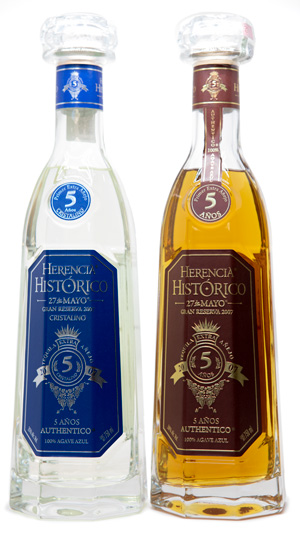 Most producers add activated carbon dust to the aged tequila, and then use cellulose (paper) filters to remove that dust (along with the color). But it’s also possible to remove color by re-distilling the product. Few use this method, however, because it takes too long, burns energy, requires a lot of cleaning of equipment, and produces less volume, due to evaporation and the cutting of heads/tails (again.)
Most producers add activated carbon dust to the aged tequila, and then use cellulose (paper) filters to remove that dust (along with the color). But it’s also possible to remove color by re-distilling the product. Few use this method, however, because it takes too long, burns energy, requires a lot of cleaning of equipment, and produces less volume, due to evaporation and the cutting of heads/tails (again.)
If filtering an aged tequila removes the color, won’t it also remove aromas and flavors?
Only if you don’t do it right, according to Master Distiller and Blender Ana María Romero Mena. Filtering only the color and leaving the aromatic characteristics of the barrel is “an art,” she says. She knows this first hand, since Louis Vuitton Moët Hennessy recently hired her to develop the flavor profile of their new Volcán de Mi Tierra tequila line, which includes a cristalino.
“It will depend on the amount (of carbon) applied per liter and the contact time, so that you can eliminate the color and leave aromas such as vanilla, caramel, maple, chocolate, and coconut, which are obtained through barrel storage,” she says. However, if too much carbon is used, or exposure is too long, aromas can be removed.
We have to admit that of the handful of cristalinos we tried for this story, only Romero Mena’s Volcán De Mi Tierra Añejo Cristalino retained the pleasant barrel aromas and flavors from aging. (In case you are wondering —and you should, in the name of transparency— we bought the bottle retail, after interviewing Romero Mena to see if what she was describing was indeed possible, so it was a happy result, and no chicanery! You can see our ratings of this tequila and other cristalinos in the Tequila Matchmaker app.)
What happens if the aromas and flavors are stripped out?
Unfortunately, many cristalino brands have not mastered the art of creating a clear, but still naturally aromatic, aged tequila. Most have been overly filtered, so that all of the color (and nearly all of the flavor) have been removed, resulting in a neutral product. In these cases, producers will often use additives to create a flavor profile*.
Of course, it’s hard to get anyone on the record to admit this, but we sampled Herencia Historico Extra Añejo (5 year) against the same tequila made into a cristalino. The original extra añejo is full of barrel flavors such as caramel, oak and vanilla, with a rounded mouthfeel. The cristalino version is watery in the mouth with little flavor, and an astringent finish.
We also tried Tierra Noble Reposado, against the cristalino version. The repo is pleasant with light barrel flavors, while the cristalino version has a very strong eucalyptus flavor.
Volcán De Mi Tierra Añejo Cristalino, however, is able to retain aromas and flavors of the barrel. If you look closely, you’ll see the reason why. It still retains a slight tint of color.
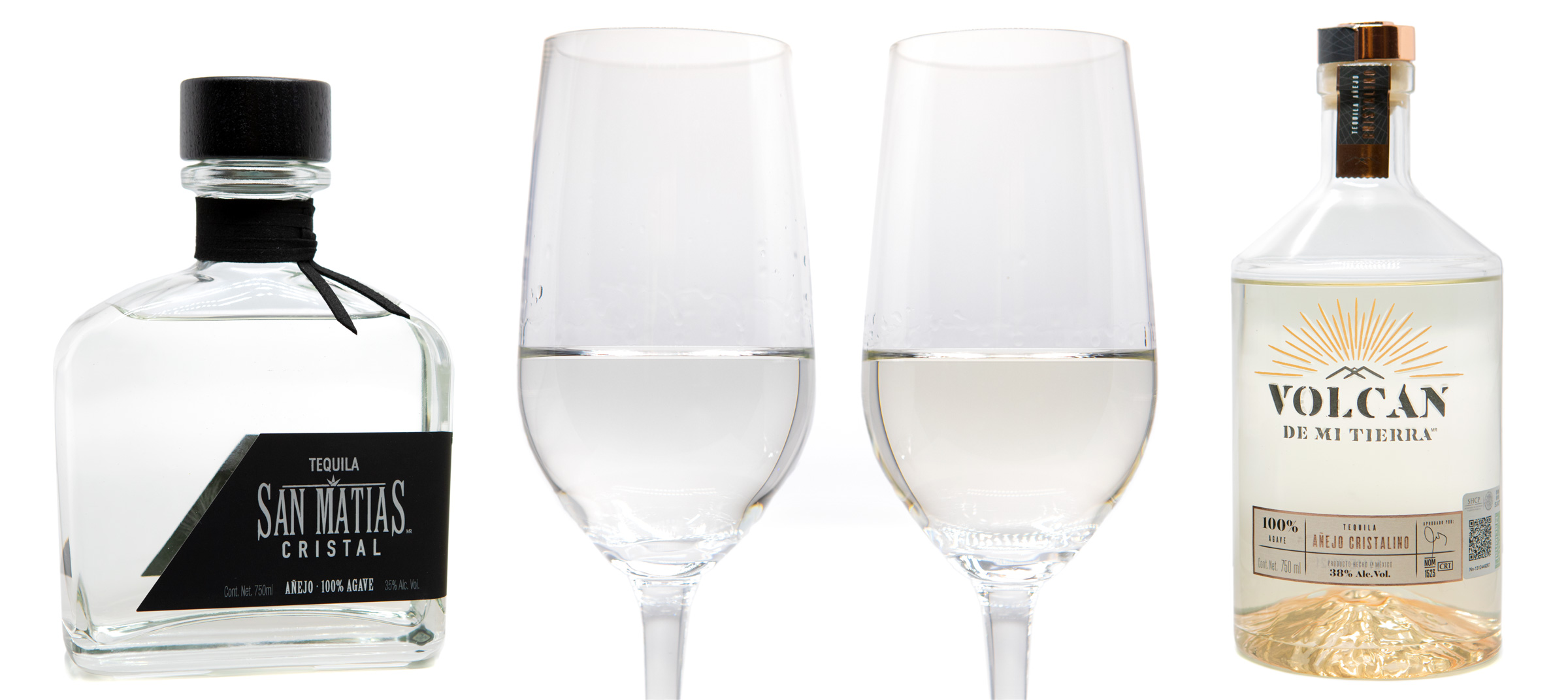
We also tried San Matias Cristal, which is absolutely clear. The aroma is dominated by vanilla and cake batter aromas, and the flavor is overwhelmingly vanilla and sweet.
How does filtering affect mouthfeel?
“If the elimination of the color is done in the right amount, it should be silky, since the barrel produces esterification,” says Romero Mena.
(Esterification is the process by which alcohols and carboxylic acids make esters, which affect mouthfeel.)
“(Esterification) must be respected in this process,” she adds.
Indeed, in the cristalinos we sampled, the mouthfeel was lighter. Some brands water down their cristalino version (the Herencia Historico cristalino was 35% abv, versus 38% in the original), but even the samples at the same proof had a lighter mouthfeel overall.
Herradura Ultra goes one step further in altering the cristalino by adding agave syrup to make it sweeter and more appealing to non-traditional tequila drinkers.
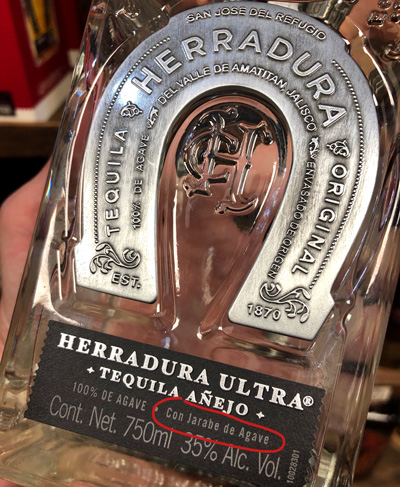
So, now that we’ve walked you through how cristalinos are made, the question remains: Why?
A big part is marketing. Clear añejos represent something new and a little “showy.” There is always a market for this type of product, and it works particularly well in Mexico, where consumers like to bring a fancy, expensive-looking bottle to parties and frankly aren’t as nerdy in general about tequila as their U.S. counterparts.
“It’s the fashion right now,” says Emilio Ferreira Ruiz, owner of the El Buho tequila store in Tlaquepaque, Jalisco, who has recently seen a surge in Mexican customers looking for cristalinos. Zack Romaya, owner of Old Town Tequila in San Diego, CA, agrees, saying he has seen growing demand for cristalinos over the last year, with Don Julio 70 as the most requested.
Despite the demand, Ferreira Ruiz notes that many of his customers don’t know exactly what cristalinos are. Fifty percent of customers who ask him for cristalinos think they are blancos with stronger agave flavors, and don’t realize they are aged, he says. So, in this way, cristalinos could be causing some confusion around categories. That’s why we appreciated the fact that Volcán De Mi Tierra Cristalino has a light golden color, making it visually different from a blanco. The remaining color also indicates it is not over filtered.
Interestingly, Ferreira Ruiz says that he when he provides taste-test samples to customers in his store to compare the traditionally aged tequila against the cristalino from the same brand, they usually buy the traditional añejo, even if they came in looking for the cristalino.
For Romero Mena, however, cristalinos are a great choice for beginning tequila drinkers because they are not too spicy or strong.
“It’s like when we start learning about wine” says Romero Meno, who is also a sommelier.
“First we start with sweet wines, then with whites, and end with complex reds. The same happens with tequila. (Cristalinos) are a good step for breaking the stigma that tequila is very strong, and thus educate the senses for more complex tequila.”
She admits, however, that the target market is not for connoisseurs of tequila.
“There are educated palates who are against removing what has been achieved with aging,” she says.
Looking into our Tequila Matchmaker user ratings confirms the theory that cristalinos are great for beginners, but not so much for experienced drinkers. Matchmaker user Steve Lere wrote in his review of Don Julio 70:
-
“When I first started to drink tequila a couple of years ago, this was a favorite. After trying many more, my palate has changed. Not sure why they distill everything that is tequila out. No agave. No oak.”
When we dig into more user ratings we see that Don Julio 70 has an average community rating of 83, while the original Don Julio Añejo has a slightly higher community rating of 84. The bigger difference comes from our tequila panel members—more experienced drinkers— who gave Don Julio’s cristalino an average score of 70, versus 81 for the non-filtered añejo.
What about the price?
In general, cristalino products are more expensive.
Our pricing research shows that consumers in Mexico are willing to pay more for a clarified, aged tequila. The average price for a cristalino in Mexico is 30% more than its non-clear counterpart. In the United States, the price is only 16% higher.
Is this a new category of tequila?
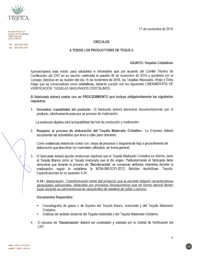 Not officially. At this point, the best answer we can give is “kind of”. The Tequila Regulatory Council (CRT) permits cristalinos. In fact, at a Nov. 2016 meeting, the CRT’s technical committee laid down some standards for the clear, aged tequilas, without actually naming it a new category.
Not officially. At this point, the best answer we can give is “kind of”. The Tequila Regulatory Council (CRT) permits cristalinos. In fact, at a Nov. 2016 meeting, the CRT’s technical committee laid down some standards for the clear, aged tequilas, without actually naming it a new category.
Under the committee rules, producers must show documentation that the product was actually barrel aged, as well the process by which it was made clear. This is where it gets interesting—the committee said that these rules exist to show why cristalinos are distinct, like the categories of blanco and aged tequilas.
What’s more, it says that the “de-colorization” process must conserve some of the aging attributes obtained in the barrel. So, over-filtering and completely stripping away the aromas and flavors created during their time in the barrel, is presumably not permitted.
Our Take
Cristalinos appear to be a curious in-between expression. Of course, we are further in our tequila journey than others, so maybe these would have been a nice entry point. But when we see them all over the Mexican market we worry a little that people will soon expect all tequilas to be so gentle and “smooth” that more traditional products could fall out of favor, or they will confuse them with what should be an agave-forward blanco. We’ll see!
Have you tried cristalinos? If so, rate them in the app and let us know what you think!
*These additives are permitted by the CRT, as long as they do not constitute more than 1% of the volume. But, additives these days are so advanced, it takes very little to completely change the aroma, flavor, and body of the liquid.


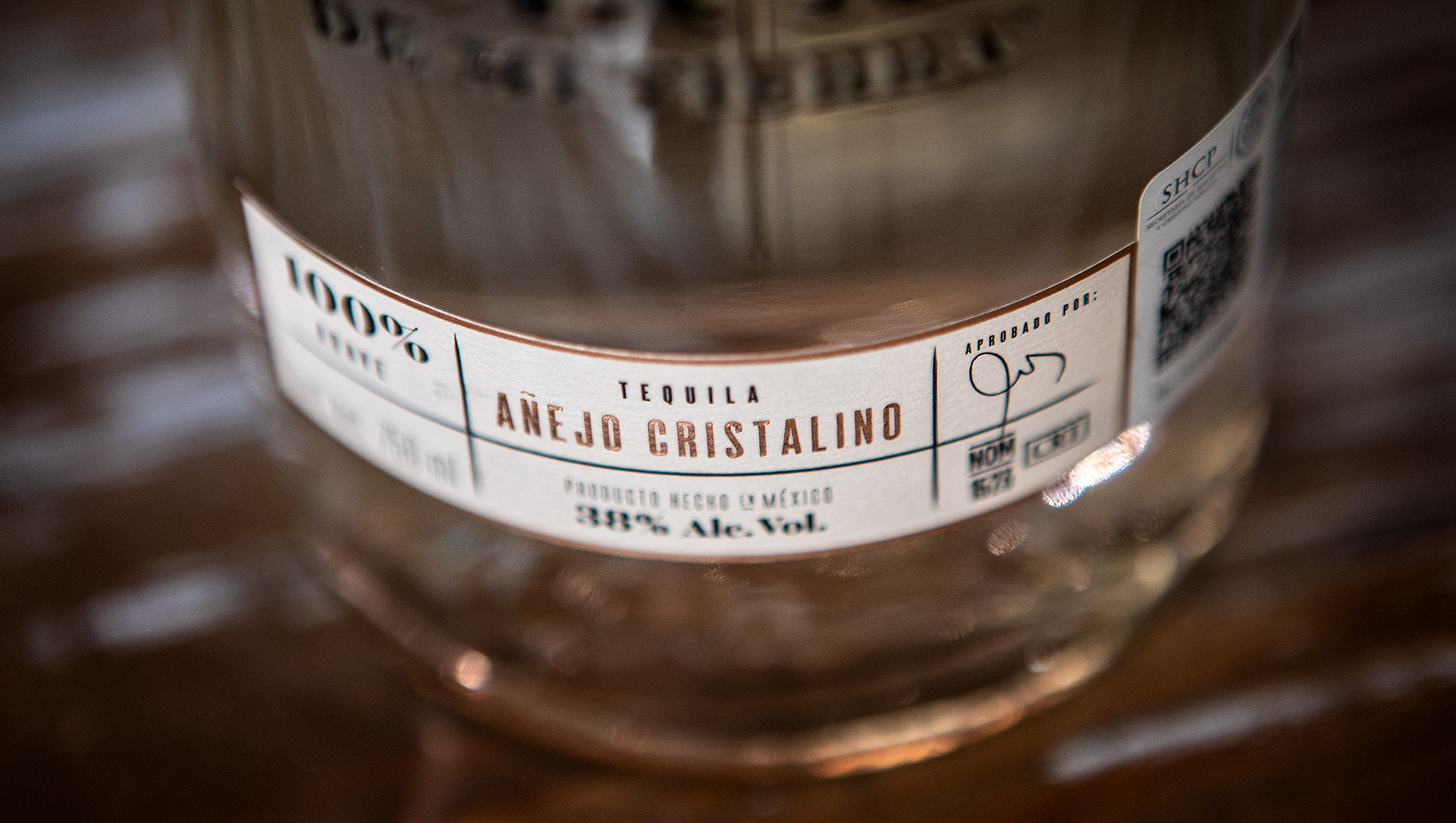
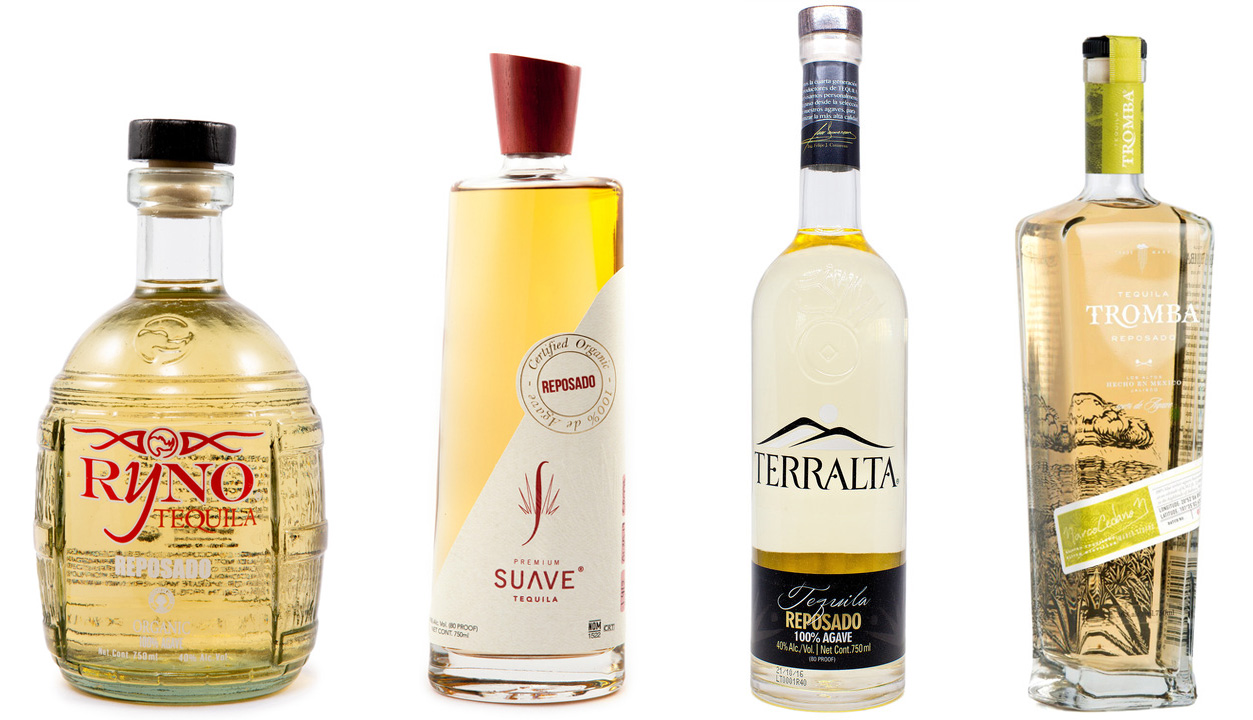
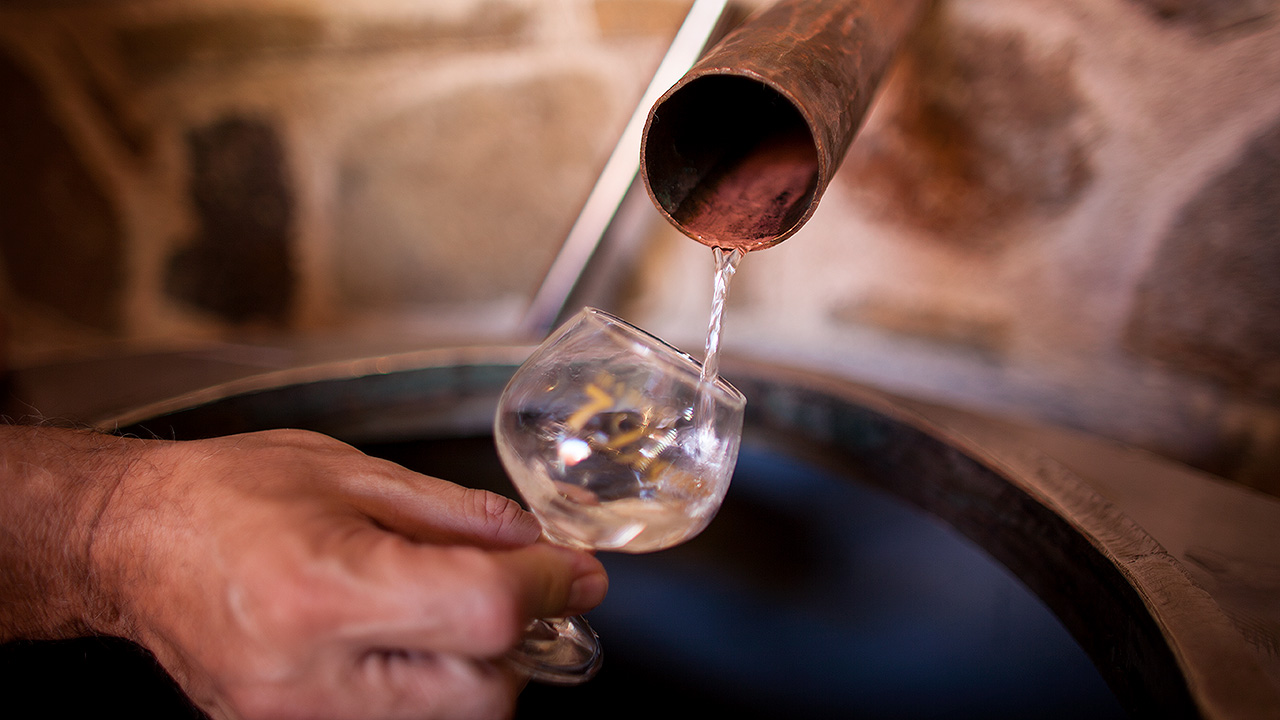
Me, as a tequila maker, wont ever produce a cristalino tequila. No matter how atractive is the bussines, for me Will always more important to produce a tequila that makes me feel proud, and making “easy” drinkable, “sweet” and low alcohol tequilas is not a way to feel proud about something.
Correcto, deja de ser tradición por una moda snob que borra (filtra) las verdaderas caracteristicas del tequila!!
Interesting article as usual, and very informative. I will never buy a Cristalino myself, but have tried many and dislike them all, especially Don Julio 70. Don’t we have enough “gateway” tequilas to hook people in, like the artificial tasting Casamigos and Clase Azul? Why make such a gimmick as Claros? I see it’s basically aimed towards Mexico, and how sad that the country that brought us this amazing spirit, with it’s wonderful traditions and history, would have people want this bastardization of their magical elixir. I am happy to hear Jaime say what he did. I respect his Suave brand of tequilas, and for a major Mexican Producer/Master distiller say this is refreshing. I hope more brands in Mexico will refuse to just cash in on this Gimmick.
Thanks for another thoughtful article!
Clearly you seem to like the Volcan Cristalino quite a bit since you make reference to it several times. However, upon checking the Tequila Matchmaker community scores it is actually Revolucion Anejo Cristalino that gets the highest rating (91pts). Volcan (88pts) and the others mentioned in the second paragraph are noticeably well behind Revolucion. Curious to learn if you tasted that one and what you thought.
Hi Adrian. We haven’t tried it yet, but have noticed it is the highest scoring cristalino on TMM thus far.
Well, please let me add yet another angle to this article…or at least to the comments. Hopefully I speak for a yet unrepresented group.
I have been a Tequila and Mezcal drinker for 46 years, in and out of 75% of Mexico. I put myself in a group of non-elitist Tequila drinkers who simply love Tequila and introducing it to others, explaining the processes, and generally imparting knowledge – kinda like true wine lovers, I guess.
I would rarely disagree with mi amigo Emilio Ferreira Ruiz, as I often say he has the best store and a huge knowledge of Tequila in Mexico. He and all my other friends know my story:
In many years I was never able to enjoy any aged Tequila, as drinking Tequilas aged in an oak barrel immediately hit my gag reflex as badly as Scotch. Since late 2010, when they launched ahead of their 70th anniversary, I have joked that Don Julio made their ‘70’ for me. I’m working my way through the “now fashionable” brands in this article and others, and I am extemely happy to have a whole new lineup to add to the 14-15 favorite Tequilas in my home bar.
…and Yes, I detest the huge difference in prices of ‘70’ from store to store – from US$26 here yesterday to US$70 in Texas last month. …or maybe I should keep that a secret. :)
Scarlet and Grover – thanks to both of you for another thoughtful and informative article/report. It illuminates many of angles on the “crystalino” tequilas. Thanks again and we’re wishing y’all a very merry Christmas, happy Holidays, and the best of everything in this approaching year.
Cristalinos were my introduction to tequilas. Started with Don Julio 70, Herradura Ultra, etc. I thought they were “smoother”. But eventually they started tasting too sweet, so I moved to regular anejos. Now I prefer blancos and reposados. I prefer not so sweet now, and welcome the heat.
Thanks for sharing, David. It sounds like we had a similar path. However, when we got started, cristalinos didn’t exist!
En conclusión en que orden son los mejores , soy de Xalapa-Ver mex
I’ve had 1800 Crisilanio and it was great. A fantastic sipping tequila. Personally I want to taste the aged tequila not the oak.
En pocas palabras: 1 si quieres un buen tequila de entrada que sea Mexicano que lleve la marca Tequila eso garantiza 100 agave Azul,
2.- Añejo el mejor que representa el trabajo y sabor para mi.
3.- Cristalino si ya están grande y quieres algo más controlado en alcohol, sabores y darte el gusto de conocer. O si eres joven si solo quieres gastar por verte Nice aunque no sepas nada de Tequila. La mala de empezar con cristalinos que cuando pruebes los mejores añejos quizás se te hagan fuerte ya ni hablar del buen blanco.
4 Me hubiese gustado mas información de la doble destilación en comparación del filtrado, he probado 1800 Cristalino y Don julio 70 me dejó mejores notas el 1800 C. e iba por un Dobel, Pero ahora con las marcas de puntuación que recomienda iré por ella solo para degustar como dicen por ahí, sobre todos si al final cuando quieras algo más natural ya sabes que tequila tomar. Excelente comentario de todos. Saludos
This blog, along with your other blog re: smooth, go hand in hand. I started drinking and paying attention to what I was drinking about 15 + years ago. The bottle design was my first attraction=- I know, I know, but you gotta start somewhere, don’t ya?- then I learned about the NOM and the three types: blanco, Reposado, and Añejo. I, too, soon discovered these super filtered Cristalino’s (Don Julio 70th) and lauded their smoothness. And, I soon realized something was missing. With all that filtering, the essence of the agave was gone. I’m not ready to dismiss Cristalino’s and will keep an open mind, but it won’t be my first recommendation or choice when gifting, drinking, or otherwise enjoying tequila.
I’ve been drinking tequila in So Cal before some companies had an Anejo (I’m dating myself). Recently, my tasting parties have attracted more people towards drinking Cristalino’s rather than traditional Anejo’s. Some people who may have had a bad experience with a Reposado will try a Cristalino but not an Anejo. I also see the younger crowd gravitating toward Cristalino’s probably because they are sweeter. A bottle of Don Julio 70 will be finished at one party and yet I’ve had the same bottle of 1942 for 5 parties. I’m not a traditionalist and I think as more people drink Cristalino’s the popularity will increase and they will be here to stay, IMHO. Salud!
New to the forum but if you grew up drinking Tequila and Squirt with your Tios, it’s hard to argue against Cristalinos. Personally, I enjoy a blanco and anyone that takes the time to taste the spirit. I am now an admirer of process and Tequileros with heritage. Mexicanos drink to remember.
No soy en experto en tequila, simplemente estoy aprendiendo de todos aquellos que tienen la experiencia para poder opinar sobre este tema. Gracias a que encontré este articulo estaré atento al momento de degustar esta variedad de tequila. Me encanta el sabor a agave y si en estos tequilas se pierde no los consumiré ni por moda ni tendencia.